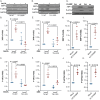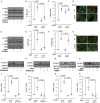This is a preprint.
Integrin-Specific Signaling Drives ER Stress-Dependent Atherogenic Endothelial Activation
- PMID: 40501821
- PMCID: PMC12154597
- DOI: 10.1101/2025.05.31.654582
Integrin-Specific Signaling Drives ER Stress-Dependent Atherogenic Endothelial Activation
Abstract
Atherogenic endothelial activation arises from both the local arterial microenvironment-characterized by altered extracellular matrix composition and disturbed blood flow-and soluble proinflammatory stimuli such as oxidized low-density lipoprotein (oxLDL). Fibronectin, a provisional extracellular matrix protein enriched at atheroprone sites, enhances endothelial activation and inflammation triggered by oxLDL and disturbed flow. Although endoplasmic reticulum (ER) stress contributes to vascular dysfunction, the role of matrix composition in regulating ER stress remains unknown. We show that oxLDL and disturbed flow induce ER stress selectively in endothelial cells adhered to fibronectin, whereas both stimuli fail to induce ER stress in cells on basement membrane proteins. This matrix-specific ER stress response requires integrin activation, as endothelial cells deficient for integrin activation (talin1 L325R mutation) fail to activate ER stress in response to disturbed flow and oxLDL and direct stimulation of integrin activation using CHAMP peptides is sufficient to trigger ER stress. Blunting endothelial expression of fibronectin-binding integrins (α5, αv) using siRNA prevents ER stress in response to atherogenic stimuli in vitro, whereas endothelial α5 and αv deletion reduces ER stress at atheroprone sites in vivo. The mechanisms driving integrin-dependent ER stress remain unclear, since matrix composition does not affect protein translation, unfolded protein accumulation, or superoxide production, and scavenging superoxide (TEMPOL) does not reduce integrin-dependent ER stress. Inhibiting ER stress with TUDCA reduces proinflammatory and metabolic gene expression (bulk RNAseq) but does not prevent NF-κB activation, a classic proinflammatory transcription factor. Rather, TUDCA prevents activation of c-jun N-terminal kinase (JNK) and c-jun activation, and blocking JNK (SP600126) or c-Jun activity (TAM67) prevents proinflammatory gene expression following both stimuli. Together, these findings offer new insight into how the arterial microenvironment contributes to atherogenesis, with fibronectin-binding integrin signaling promotes ER stress in response to mechanical and metabolic stressors, thereby amplying proinflammatory endothelial activation through JNK-c-Jun signaling.
Keywords: Atherosclerosis; ER Stress; Inflammation; Integrin; Oxidized LDL; Shear Stress.
Conflict of interest statement
Disclosures The authors declare that the research was conducted in the absence of any commercial or financial relationships that could be construed as a potential conflict of interest.
Figures






References
-
- Martin S.S., Aday A.W., Allen N.B., Almarzooq Z.I., Anderson C.A.M., Arora P., Avery C.L., Baker-Smith C.M., Bansal N., Beaton A.Z., Commodore-Mensah Y., Currie M.E., Elkind M.S.V., Fan W., Generoso G., Gibbs B.B., Heard D.G., Hiremath S., Johansen M.C., Kazi D.S., Ko D., Leppert M.H., Magnani J.W., Michos E.D., Mussolino M.E., Parikh N.I., Perman S.M., Rezk-Hanna M., Roth G.A., Shah N.S., Springer M.V., St-Onge M.-P., Thacker E.L., Urbut S.M., Van Spall H.G.C., Voeks J.H., Whelton S.P., Wong N.D., Wong S.S., Yaffe K., Palaniappan L.P., American Heart Association Council on Epidemiology and Prevention Statistics Committee and Stroke Statistics Committee, 2025 Heart Disease and Stroke Statistics: A Report of US and Global Data From the American Heart Association, Circulation (2025). 10.1161/CIR.0000000000001303. - DOI
-
- Sorescu G.P., Song H., Tressel S.L., Hwang J., Dikalov S., Smith D.A., Boyd N.L., Platt M.O., Lassègue B., Griendling K.K., Jo H., Bone morphogenic protein 4 produced in endothelial cells by oscillatory shear stress induces monocyte adhesion by stimulating reactive oxygen species production from a nox1-based NADPH oxidase, Circ Res 95 (2004) 773–779. 10.1161/01.RES.0000145728.22878.45. - DOI - PubMed
Publication types
Grants and funding
LinkOut - more resources
Full Text Sources
Research Materials
Miscellaneous
